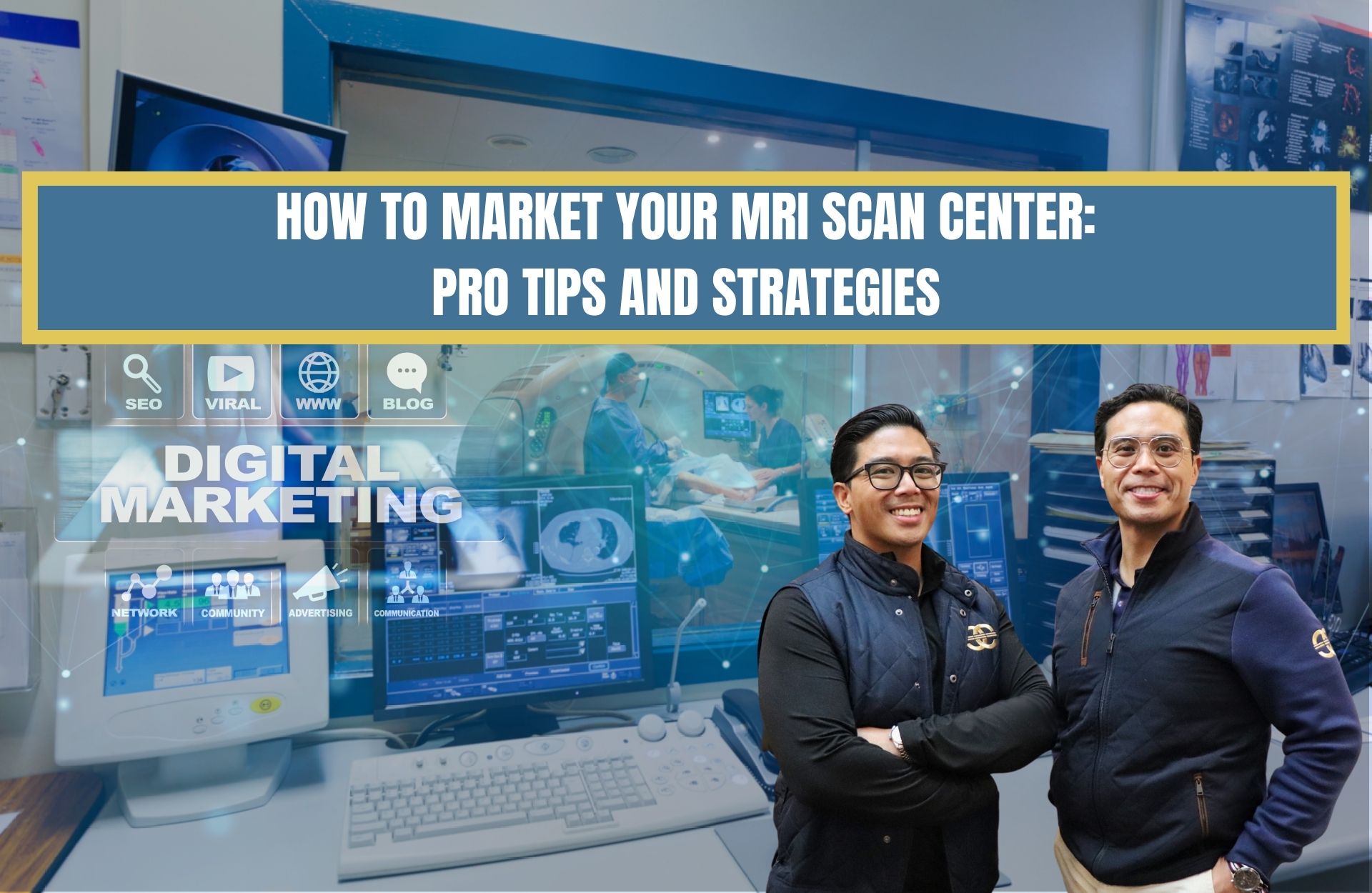
Magnetic resonance imaging (MRI) scans have become an increasingly common medical imaging technique over the past few decades. MRI uses magnetic fields and radio waves to produce detailed images of the human anatomy, allowing doctors and radiologists to make accurate diagnoses without exposing patients to ionizing radiation.
As healthcare practices strive to provide patients with convenient access to advanced imaging, MRI and other scanning centers have proliferated rapidly across the United States and globally. There are now thousands of MRI facilities providing services to patients who require imaging for preventive screening, chronic conditions monitoring, acute injury diagnosis, and more.
The purpose of this article is to explore practical marketing strategies for MRI centers looking to attract new patients and radiology referrals. We’ll examine proven techniques to increase visibility, build community relationships, improve the customer experience, and measure marketing success. With the right approach, an MRI facility can stand out from competitors and ensure continued growth and profitability.
Target Audience
The target audience for an MRI scan center includes both patients seeking scans and doctors referring patients for scans.
For patients, the key demographics are adults over 40 years old who are more likely to need diagnostic imaging for conditions like joint injuries, chronic pain, strokes, tumors, and other age-related health issues. The psychographics lean towards middle to upper-middle class patients with health insurance coverage. Their needs center on getting accurate diagnostic scans to assist their doctor in assessing and treating medical conditions. Their behaviors will be researching MRI providers in their location, comparing cost and convenience, and scheduling appointments based on referrals.
For referring doctors, the target audience spans primary care physicians, orthopedists, neurologists, oncologists, and other specialists who rely on MRI scans for diagnosing patients. Their needs are getting fast, convenient referrals for their patients and receiving detailed, accurate scan reports. Their behaviors include referring patients to trusted MRI providers, specifying the type of scan needed, and reviewing results. Building relationships with local practices can encourage doctor referrals.
The MRI center should cater to both groups, emphasizing accuracy, convenience, cost-effectiveness, and patient experience. Multiple locations can also help attract more patient and doctor referrals within a geographic area.
Competitive Analysis
Analyzing your competitors’ marketing and positioning is crucial to developing your own successful marketing strategy. When it comes to MRI centers, pay attention to factors like:
– Locations – Where are competing MRI centers located? Are they conveniently located for your target demographic? Is there an area with high demand but no MRI center nearby? Identify geographic gaps you can fill.
– Pricing – What do competitors charge for various MRI scans? Where can you undercut pricing to attract budget-conscious patients? Or can you position as a premium, higher-quality center and charge more?
– Referral relationships – What healthcare providers refer patients to competitors? Can you establish and nurture relationships with those providers to get referrals?
– Marketing messaging – How do competitors market their centers and MRI services? What messaging resonates with your target patients? What pain points can your marketing address?
– Customer experience – How convenient is scheduling? Are staff friendly and facilities clean? Identifying service shortcomings to excel at.
– Digital marketing – Analyze competitors’ websites, SEO, and online reputation. Can you claim the top organic search rankings in your area? How responsive are they on review sites?
– Branding – What brands do competitors associate themselves with? Can you partner with hospital systems or radiology groups to build credibility?
Doing this competitive analysis will reveal the positioning, pain points, and perception gaps to help inform and sharpen your own MRI center’s marketing strategy. The goal is to identify weaknesses to exploit and strengths to emulate or surpass.
Location & Accessibility
When determining the ideal location for an MRI scan center, accessibility should be a top priority. MRI machines are large and expensive, so most centers can only operate one or two machines at a time. This limits patient volume, so drawing in patients from a wide geographic area is key.
The MRI center should be located in an area with a high population density and middle to upper income demographics. Areas near hospitals and medical centers are ideal, as the MRI center can partner to receive referrals. Proximity to complementary services like orthopedic surgeon offices can also drive traffic.
Convenient access via major roads and public transportation is critical. The location should have plenty of parking spaces, with drop-off areas protected from the weather for elderly or disabled patients. Signage and directions should be clear. Waiting areas should accommodate wheelchairs, and staff should be available to assist patients getting on and off the MRI table.
A welcoming, accessible facility sends the message that patient comfort and care is the top priority. This helps attract referrals from local physicians as well as direct bookings from patients seeking a higher quality experience compared to a hospital MRI.
Pricing Strategies
When establishing pricing for an MRI center, it’s important to find the right balance between being competitive and profitable. Here are some key pricing considerations and recommendations:
Compare Pricing Models
There are a few main pricing models MRI centers use:
– Standard Fee-For-Service: This involves setting a standard price for common MRI scans like brain, spine, abdomen, etc. The benefit is transparency and simplicity. The drawback is less flexibility in pricing.
– Bundled/Package Pricing: Offering discounted bundled prices for common groupings of scans (e.g. brain + cervical spine package). This can incentivize customers to do more scans with you.
– Membership/Retainer: Offering unlimited MRI scans for a monthly or annual membership fee. This can help build loyalty.
– Dynamic/Customized Pricing: Price can vary based on factors like demand, time of day, who is referring the scan, etc. More complex but allows price optimization.
– Cash Discounts: Offering discounts for self-pay patients paying cash rather than billing insurance. This attracts price-sensitive patients.
Recommended Pricing Strategies
– Benchmark competitors’ pricing in your area, but don’t just match it – look for strategic opportunities to go slightly lower on high-volume scans.
– Consider bundled scan packages and loyalty programs to drive higher lifetime value per patient.
– Offer cash discounts of 20-30% to attract self-pay patients. Require payment upfront for the discount.
– For high-demand times, consider surging prices moderately above normal rates. Similarly, offer discounts for off-peak hours.
– Adjust prices annually based on market conditions, costs, and competition. Increase rates slowly over time rather than drastic moves.
– Provide price transparency by making pricing easily accessible. Build trust by being clear upfront about costs.
– Negotiate direct contracts with employers, unions, and insurers to become an in-network provider. Offer reasonable rates in return for patient volume.
The goal is competitive pricing that maximizes profitability while still making your services accessible to patients, doctors, and health plans in your market. Analytics and optimization can help find that pricing sweet spot.
Partnerships & Referrals
Referrals are a key source of new patients for MRI centers. Establishing partnerships and connections with local healthcare providers who can refer patients is critical. Here are some potential partnerships and referrals sources to consider:
– Primary care physicians – Build relationships with family medicine, internal medicine, geriatric medicine, and other PCPs who order MRIs for their patients. Offer educational lunches or dinners to inform them about your services. Make it easy for them to refer patients to you.
– Orthopedic practices – Orthopedic surgeons and sports medicine doctors order a high volume of MRIs. Focus marketing efforts on these specialists and foster close referral relationships. Offer them pre-authorization services to make referring patients to your center seamless.
– Neurologists and neurosurgeons – Patients with neurological conditions like stroke, epilepsy, tumors, and spine issues need MRIs. Market specifically to neuro specialists in your area to generate referrals.
– Chiropractors – Chiropractors often order MRIs to diagnose their patients’ back, neck, and spine problems. Educate them on your imaging capabilities for musculoskeletal issues. Offer conveniences like electronic ordering to get their referrals.
– Physical therapy centers – Physical therapists may recommend patients get an MRI before starting rehab. Partner with PT centers to be their preferred MRI provider. Offer prompt appointment scheduling for PT patient referrals.
– Hospitals and health systems – Establish relationships with discharge planners, care coordinators, and radiology departments at local hospitals to be referred outpatient MRIs. You may be able to lease space on hospital campuses.
– Senior living facilities – Many seniors need MRIs for conditions like arthritis and osteoporosis. Build partnerships with nearby senior and assisted living centers who can refer resident patients to your center.
– Schools and youth sports teams – School nurses and youth sports organizations may refer injured young athletes for MRIs. Develop relationships with these groups to be their imaging provider of choice.
Digital Marketing
With the rise of technology and internet usage, digital marketing strategies provide an excellent opportunity for MRI centers to increase visibility and attract new patients. Below are some key digital marketing channels MRI centers should leverage:
Search Engine Optimization
Having an SEO strategy is crucial for showing up on the first page of Google for relevant searches like “MRI near me” or “open MRI.” This involves optimizing your website content, page titles, image alt text, meta descriptions, etc. to target key phrases patients search for. Conduct keyword research to identify relevant terms and work these into your content naturally.
Social Media Marketing
Platforms like Facebook and Instagram allow creating targeted ads to reach those searching for your services in your local area. You can promote offers, share educational MRI information, and engage patients through social posts. Spend time nurturing your organic social media channels too by sharing images, videos, and blog content consistently.
Pay-Per-Click Ads
PPC ads through Google Ads and Microsoft Ads are a fast way to get your MRI center in front of people searching for your services. You only pay when someone clicks your ad, so this is an effective way to reach local patients. Target ads to your service area and tailor messaging to searches like “affordable MRI.”
Local SEO
Optimizing your Google My Business listing is imperative for ranking in local search and map results. Completely fill out your profile, add photos of your facility, encourage patient reviews, and ensure your address, phone number and hours are accurate. This helps build visibility and credibility in search results.
With a strategic approach across these digital marketing channels, MRI centers can substantially boost their discoverability and patient acquisition online. Track website traffic, leads generated, and new patient numbers to continually refine efforts over time.
Traditional Advertising
Traditional advertising methods like print, radio, and TV ads can be highly effective for an MRI center to increase visibility and establish credibility in the local community. Some tips include:
– Run print ads in local newspapers and magazines. Focus on health, medical, senior, and local lifestyle publications. Highlight the center’s services, credentials, and any special offers or discounts.
– Partner with local TV and radio stations for sponsored programming or advertisements. Morning TV health segments are a good fit. Radio ads can target drive-time commuters near your location.
– Distribute brochures, postcards, and flyers to local doctor’s offices, hospitals, clinics, senior centers, and other health-related businesses. Offer to do lectures or health screenings.
– Pitch stories to local media about the MRI center’s technology, services, grand opening, milestones, charity events, etc. News coverage lends credibility.
– Sponsor community events to get name recognition. Have a booth and hand out merch at health fairs, races, fundraisers, etc.
– Partner with sports teams and venues for naming rights, signage, game-day promotions, etc. Target relevant audiences.
– Use billboards, posters, transit ads located near medical facilities and high-traffic areas. Include a memorable tagline.
– Create giveaways like fridge magnets, pens, notepads, calendars, etc. Distribute at health fairs and doctor’s offices.
– Establish the center as an expert source for journalists. Offer spokespeople for health stories.
The goal is high-impact outreach to build awareness and position the MRI center as a trusted healthcare provider in the community through traditional advertising avenues. With a strategic local approach, traditional promotion can effectively supplement digital marketing.
Improving the Patient Experience
A positive patient experience is crucial for building loyalty and earning referrals. Here are some tips for optimizing the patient experience at your MRI center:
– Make check-in smooth and convenient. Have an efficient online booking and registration system. Send appointment reminders and pre-procedure instructions via email and text.
– Ensure exceptional front desk service. Greet all patients warmly and make them feel cared for. Keep wait times short. Follow up after the appointment.
– Offer a comfortable, relaxing environment. Have calming music, artwork, refreshments, warm blankets, and entertainment options in waiting areas and scan rooms.
– Explain the MRI process thoroughly. Educate patients on what to expect before, during and after the scan. Answer all questions patiently.
– Make patients feel safe. Provide earplugs to dampen scanner noise. Allow a companion in the room. Check on patients via intercom.
– Respect privacy and modesty. Offer gowns, blankets, and private changing areas.
– Keep patients occupied and calm. Provide music choices, TV shows, or guided meditations during scans.
– Hire friendly, patient-focused staff. Look for empathetic listeners who connect well with people. Train staff on service excellence.
– Seek patient feedback. Send post-visit surveys and encourage online reviews. Track metrics and make improvements.
With excellent customer service and a patient-first mentality, you can build loyalty, boost retention, and earn referrals for your MRI center.
Measuring Success
It’s critical for an MRI center to closely track key performance indicators (KPIs) to determine the effectiveness of its marketing efforts and return on investment (ROI). Here are some recommended metrics to monitor:
– Number of scans performed: Track the total monthly and annual MRI scans completed. Benchmark against previous time periods.
– Referral sources: Track where referrals originate from – physician referrals, partner clinics, online scheduling, etc. Analyze trends over time.
– Online leads: For digital campaigns, track website visits, contact form submissions, online appointment requests. Measure conversion rates.
– New patient acquisitions: Monitor the number and growth rate of new patients. Evaluate patient retention rates over time.
– Revenue and profitability: Calculate marketing campaign costs and track associated revenues generated. Measure overall profitability and ROI.
– Customer satisfaction: Conduct surveys to measure patient satisfaction. Monitor online reviews. This indicates if marketing is attracting the right customers.
– MRI capacity utilization: Calculate the percentage of available scanner capacity being utilized. Low utilization signals a need for more effective marketing.
– Market share: Estimate the center’s share of the local MRI market. Increased share demonstrates effective marketing.
By regularly analyzing these KPIs, an MRI center can determine what marketing strategies are most effective so it can optimize accordingly. The metrics provide vital data to inform marketing decisions and investments.

In an increasingly competitive healthcare landscape, hiring a medical marketing agency can be a game-changer for your practice’s success. By leveraging our industry-specific expertise, personalized strategies, and data-driven approach, you can enhance your online presence, attract new patients, retain existing ones, and strengthen your brand.
With Estro Medical Marketing as your strategic partner, you can navigate the complexities of healthcare marketing while optimizing your resources and focusing on what you do best—providing excellent patient care.
New Jersey
Headquarters
263 Center Ave #3
Westwood, NJ 07675
+1 201-203-7033
Locations
National Digital Agency

About Us
Estro Medical Marketing
Copyright © 2025 Estro Medical Marketing. All Rights Reserved.
